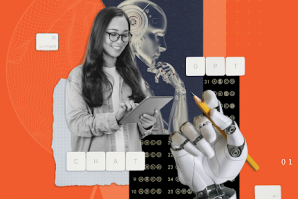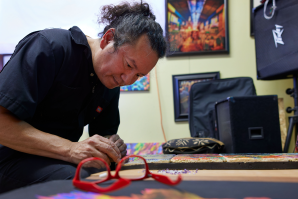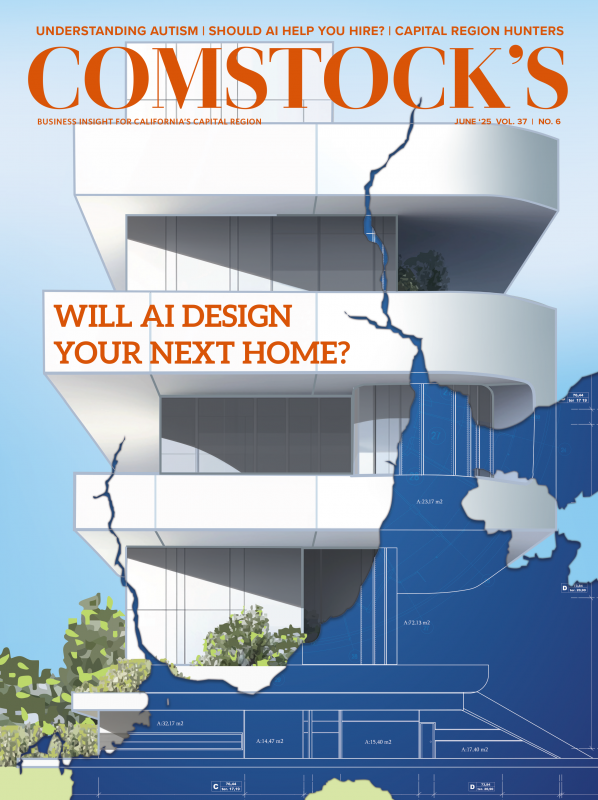In a recent AIA Central Valley presentation on artificial intelligence and architecture, designer Jake Favour was testing the hypothesis of what it would look like to build housing on the Sacramento-San Joaquin Delta. One design imagines a series of hut-like abodes suspended above the water and interconnected by a warren of wooden walkways. Others depict a group of glass-walled cubes and individual silos integrated into nature.
“Historically, we don’t build there because it’s a flood zone and there are environmental concerns, so I was using AI to test the design hypothesis of what it would look like if we could overcome those things,” says Favour. “AI is very powerful as an imaginary tool to help people test and explore ideas.”
Co-presenter Mark Roddy, architect with SmithGroup and a lecturer at Sacramento State, considers himself an architectural purist but admires people who are using AI in new, creative ways to challenge convention. “I fundamentally believe architecture is rooted in structure, organizational strategies and bigger ideas without the superficial side. Where AI should be pushing us is how we see materials and structure that are being transformative, and imagining architecture and space in a new way,” he says. “That’s where I get excited.”
The impact of AI on the architecture discipline is unavoidable, particularly as it gains wider acceptance. Architects are recognizing the advantages of using highly accessible generative AI apps like Midjourney, Claude.ai and Microsoft Copilot to test their design limits for the built environment, but they’re also taking a measured approach on integration and adoption into existing processes. “As creative people, we want to make sure there’s authenticity and transparency in the work we do both for ourselves and our clients, so we are being very thoughtful and intentional in our approach,” says Chelsea Pozar, president of Studio W Architects.
In the past few years, AI has become integrated into the everyday — through search engines and conversational chatbots, in driverless cars and autonomous robots. But architects are generally late to adopt and leverage cutting-edge technology. There are good reasons for that, according to Bill Kwon, chief technology officer for HMC Architects. Projects in the built environment take a long time to complete, making it difficult to add new technologies midstream, and there is a lot of risk involved with getting a project wrong or slowing it down. “There’s a certain amount of conservatism that’s built into the profession,” he says.
But that doesn’t preclude Kwon and others in the industry from exploring the possibilities. Kwon is working with the HMC team to develop a solid data strategy and the mechanisms to handle the data. “If you don’t have any of those things, AI is just relegated to using derivative AI (adapted from an existing work), something anyone can buy or subscribe to, so you are not really gaining a competitive advantage from it,” he says.
HMC is exploring a generative AI model to be reflective of their own design portfolio. Additionally, HMC is using AI to help build automation. For example, a designer can make a request for AI to help build a door that’s left-hand facing with six lights and a specific kind of hardware. Rather than having to code or script this function, AI helps generate the first pass just on the understanding of the semantic language. “It’s not perfect by any means,” cautions Kwon. “It still requires a great deal of review and supervision by our computational designers, but it’s kind of the first pass work.”
One promising benefit is the constant evolution of AI and how it adapts and learns. The technology may start to develop code in a way that an individual didn’t consider. “We all have our narrow experiences, relatively speaking, compared to the infinite number of variables AIs have access to all at the same time,” says Kwon.
Favour calls this accidental intelligence. “Yes, it’s artificial, but a lot of times it’s just accidental and you come across things that turn into a new line of questioning or a new way to look at things.”
Architect Jake Favour used AI to help imagine what it would look
like to build housing on the Sacramento-San Joaquin Delta.
(Courtesy rendering)

HMC is also exploring how AI can help with another important kind of code: building code, which must be reviewed for nearly every project. “Our goal is to narrow down the focus — so not necessarily to review all of the building code that’s required for a project, but identify the aspects of the code that carry the most risk,” Kwon says.
Pozar with Studio W is starting with a beta user group internally to see where Studio W can use AI effectively on its projects. Currently, the firm uses various publicly available open-source AI apps to assist with marketing pieces and templated proposals. “The output is sometimes spot on, and other times it’s a miss. It still requires refinement. The human component of the integration is equally, if not more important, than using the tool,” says Pozar.
Architects see the potential for workflow efficiencies, but the bigger question is where AI fits in on the design side. Is it intuitive enough to replace human designers and the mastery they’ve achieved in the space? Kwon likes to make a distinction between machine intelligence and human intelligence, particularly as it pertains to creativity. He says AI strikes directly at our emotional center, which is why there is so much hype, fear, anxiety and hope surrounding it.
“One of the common criticisms for a lot of generative AIs is that when it comes to architecture, it’s really good at creating an image that elicits an emotional reaction. The lighting is always soft and misty,” says Kwon. “And that’s by design. But when it comes to being useful, buildable, practical or even good — those are fair conversations for us to be having.”
One thing AI doesn’t currently understand is true three-dimensional space — a notable limitation in the world of design. “It doesn’t understand the sense of contraction or expansion of space, the kinds of things architects think about,” says Kwon. “If we ask ourselves if it’s better than what human beings design, I would argue that right now, no, it is not.” At the end of the day, the project must be buildable. It also must be on time and on budget, and that’s not always possible with many AI-generated designs.
Pozar uses the word evolving to describe where AI fits into the architecture design practice. “I see AI as the next wave of technology to help us be more efficient in our jobs, but it’s not going to replace humans. I think it’s an aid in creativity that’s meant to augment the human driver.”
One group that is using AI are university students. Roddy is a lecturer in the design department at Sacramento State, which offers interior architecture and architecture studies degrees. The longtime educator encourages his students to use AI tools as a starting point. “I tell my students we’re not using AI to come up with the ideas, but you can use it to help render and visualize,” he says.
That’s how Olga Zdanevich, an interior architecture student in Roddy’s studio class, likes to use the technology. “I come up with my own ideas and plans and create the forms and the model, but like to use AI to add descriptive details like time of day or point of reference. All of this is already in the model, but AI provides a way of conducting a rendering from your work,” she says.
Each year, Roddy’s students submit projects for a design and build competition sponsored by the Museum of Outdoor Arts in Denver, Colorado. The prompt this year focused on designing a land art installation in Yosemite National Park. Many of the students used Diffusion — an AI attachment in SketchUp — and were able to create a quick rendered visualization. However, many of the iterations did not reflect their design intent.
“I think the learning outcome of this was that AI is good for conceptualizing ideas, but not for finished renders,” says Roddy. “Despite that, some of the renderings were actually quite compelling, and the students did a good job of hacking the system.”
Zdanevich noticed some of the challenges with Diffusion as well. “The program will listen to you to an extent, then add its own kind of process,” she says. For example, a small wall was added in her project that she did not specify. After the peer review process, she had time to make corrections before submitting her final pavilion project, which consisted of two tetrahedron forms rotated with openings and an angled wall with seating to mimic Yosemite’s large dome and rock formations.
Zdanevich believes creatives have a choice with AI. “I think AI is prevalent in our society today, and you can either fear it or learn how to use it well. I believe it’s an aid for human function and for human ease in the workplace and can be convenient if used properly, but when it comes to the experience of doing the job for years and years, and the human touch, human understanding and human capability of learning, I don’t think that can be replaced,” she says.
Using new technologies like AI, Roddy would like to see his students come out of school with the confidence to become their own creative force. “I really see technology and AI leveling the playing field and empowering our students, so that people coming out of school who are creative thinkers and who are thinking outside the box are being honored, not because they are experts, but because they think differently and can solve problems in new and creative ways,” he says.
Each architect and firm will need to choose their path forward, depending on their goals and desires. “I think AI will find its way into most people’s practice, whether they choose it, or it’s just quietly running in the background,” says Favour. “Either way, these tools are touching their work in some capacity somewhere. I think the creative aspects are only going to get more interesting.”
–
Stay up to date on business in the Capital Region: Subscribe to the Comstock’s newsletter today.
Recommended For You

AI in Education: Helpful Tool or Sinister Danger?
Most college professors are wary of it, but others embrace it as a learning advantage
All around the world, academic institutions, from the renowned online Khan Academy through to leading research universities, are grappling with the extraordinarily rapid rise of artificial intelligence systems capable of generating human-like responses to complex questions.

Bracing for the AI Revolution
How Capital Region creatives are adapting to generative AI
If you could create an image of anything in the world, what would it be? The house you lived in when you were six? A design for a new wine label? An oil painting of your dog dressed as Napoleon? Generative artificial intelligence has made this a possibility.

Bracing for the AI Revolution with Eric Howard
PODCAST EPISODE: Fathom co-founder Eric Howard discusses generative AI tools, artistic value and how creatives can adapt to a changing industry.

Leading the Way on Housing
Multifamily unit construction in Sacramento 'is booming'
In the last four years, Sacramento has approved more than 11,000 housing units, the third-highest total in the state, according to figures from the California Department of Housing and Community Development. The city’s total of approved housing trails only Los Angeles and San Diego, both of which are much larger cities.




